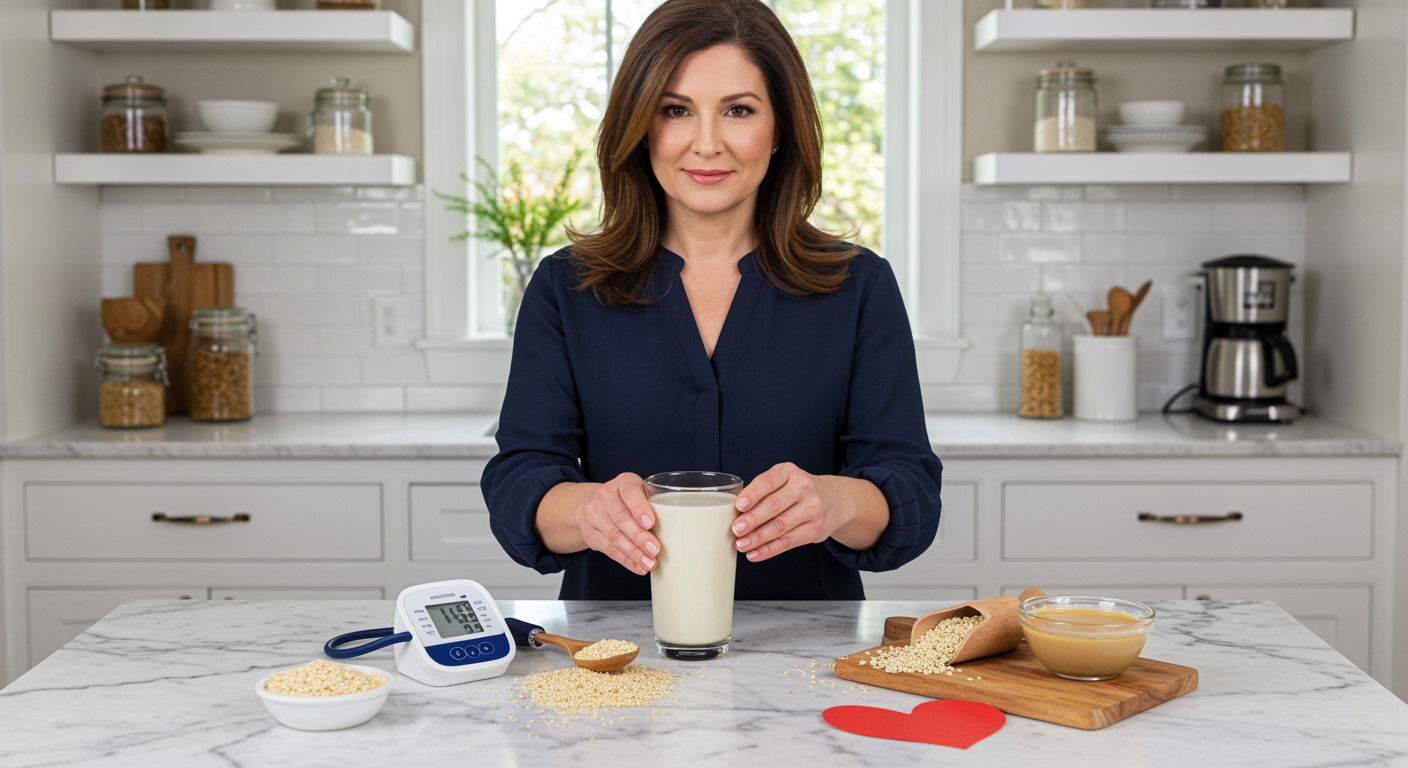✪ Key Takeaway: Sesame milk may help lower blood pressure due to its magnesium, lignans, and healthy fats that support cardiovascular health.
Introduction
Your morning routine might be missing a powerful ally against high blood pressure.
You probably wonder if switching from regular milk to plant-based alternatives could actually make a difference in your cardiovascular health.
Hi, I’m Abdur, your nutrition coach and today I’m going to explain how sesame milk affects your blood pressure and whether this creamy alternative deserves a spot in your daily routine.
What Makes Sesame Milk Special For Blood Pressure?
Sesame milk contains a unique combination of nutrients that work together to support healthy blood pressure levels.
The magnesium content in sesame seeds acts as a natural calcium channel blocker, helping your blood vessels relax and reducing the pressure against arterial walls.
Research shows that people with higher magnesium intake have significantly lower systolic and diastolic blood pressure readings compared to those with magnesium deficiency.
Sesame seeds also contain powerful compounds called lignans, particularly sesamin and sesamolin, which have been shown to improve cardiovascular function.
These lignans work by reducing inflammation in blood vessels and improving the flexibility of arterial walls, making it easier for blood to flow smoothly throughout your body.
✪ Fact: One cup of sesame milk provides about 25% of your daily magnesium needs.
How Does The Science Support These Claims?
Multiple studies have examined the relationship between sesame consumption and cardiovascular health with promising results.
A clinical trial published in the Journal of Nutritional Science found that participants who consumed sesame oil daily for 45 days experienced significant reductions in both systolic and diastolic blood pressure.
The mechanism behind this effect involves the activation of nitric oxide production in blood vessels, which causes them to dilate and reduce pressure.
Another study demonstrated that the healthy fats in sesame seeds, particularly oleic and linoleic acids, help improve cholesterol profiles while supporting overall heart health.
These fatty acids work by reducing inflammation markers in the blood and preventing the oxidation of LDL cholesterol, which can damage arterial walls and contribute to high blood pressure.
The antioxidant properties of sesame lignans also protect blood vessels from free radical damage, maintaining their elasticity and proper function over time.
✪ Pro Tip: Choose unsweetened sesame milk to avoid added sugars that could counteract blood pressure benefits.
What About Sodium Content And Other Concerns?
Commercial sesame milk products vary significantly in their sodium content, which directly impacts their effect on blood pressure.
Many store-bought versions contain added salt for flavor enhancement, which can counteract the natural blood pressure lowering benefits of sesame seeds.
Reading ingredient labels becomes crucial because some brands add up to 150mg of sodium per cup, while others contain less than 10mg.
The processing method also matters because heavily processed sesame milk may lose some of its beneficial lignans and antioxidants during manufacturing.
Homemade sesame milk gives you complete control over sodium content while preserving maximum nutritional value from the raw sesame seeds.
You can easily make it by blending soaked sesame seeds with water and straining the mixture, ensuring you get all the natural compounds without unwanted additives.
✪ Note: Always check labels for sodium content as some brands contain over 10 times more salt than others.
How Much Should You Drink For Blood Pressure Benefits?
The optimal amount of sesame milk for blood pressure benefits depends on your overall dietary pattern and individual health status.
Studies suggest that consuming one to two cups daily provides sufficient magnesium and lignans to support cardiovascular health without overdoing calories.
This amount delivers approximately 200-400mg of magnesium, which represents a significant portion of the recommended daily intake for most adults.
However, you should consider sesame milk as part of a comprehensive approach to blood pressure management rather than a standalone solution.
Combining sesame milk with other heart-healthy foods like leafy greens, berries, and whole grains creates a synergistic effect that amplifies the blood pressure lowering benefits.
Remember that consistency matters more than quantity, so incorporating moderate amounts of sesame milk into your daily routine will yield better results than occasional large servings.
✪ Pro Tip: Start with half a cup daily and gradually increase to assess your individual tolerance and response.
The Bottom Line
Sesame milk can indeed help lower blood pressure through its rich magnesium content, beneficial lignans, and heart-healthy fats that work together to support cardiovascular function.
Small dietary changes create big health transformations when you choose them wisely and stick with them consistently.
I would love to hear about your experience with sesame milk or any questions you might have about incorporating plant-based alternatives into your blood pressure management routine, so please share your thoughts in the comments below.
References
At NutritionCrown, we use quality and credible sources to ensure our content is accurate and trustworthy. Below are the sources referenced in creating this article:





